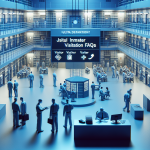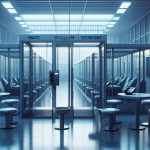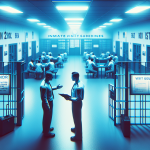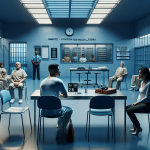Visiting an inmate in a Maximum Security Unit can be a daunting prospect for both the visitor and the inmate. Understanding the rules and expectations of inmate visitation is critical for having a successful and secure visit. %%Iterable%% Inmate Visitation Overview outlines the regulations and protocol that must be followed in order to visit an inmate in a Maximum Security Unit.
Visitors must be pre-approved by correctional staff, and restrictions may vary depending on the institution. Visitors must provide valid photo identification and must generally be 18 years of age or older unless accompanied by an approved adult. It’s important to be aware that, regardless of any restrictions, any individuals with a violent history or previous criminal convictions may still be prohibited from visiting.
Visiting hours are set by each institution, so it’s important to check with the staff before planning your visit. Visitation times may be limited to certain days, or limited to a few hours at a time. Generally, a Maximum Security Unit will allow one hour of visitation per day. For this reason, it’s important to plan ahead when scheduling your visit.
To ensure the safety of the inmates and visitors, certain items may not be brought into the facility. All visitors must pass through a metal detector prior to the visit, and visitors are not allowed to bring any items that could potentially be used as a weapon, such as pocket knives, scissors, etc. Though visitors are not permitted to bring in objects to be used during visitation, certain facilities may offer items for sale during the visit, such as snacks and toys.
Following these protocols is essential for keeping a safe and secure environment for inmates and visitors alike. By understanding and adhering to %%Iterable%% Inmate Visitation Overview, visitors can do their part to make sure their visit is safe and successful.
Maximum Security Unit – Overview and Information
A maximum security prison or unit is a prison designated to house individuals who pose a risk to public safety or who are deemed particularly dangerous. These individuals are provided with the highest level of security measures.
Access into a maximum security unit is restricted to only authorized personnel, with visitors and inmates screened upon entering and leaving. Visitors must go through rigorous background checks and are also accompanied by a security personnel at all times. Inmates are monitored 24/7 with guard towers, surveillance cameras and high walls often surrounding the area.
Inmates are usually placed in single cells or dormitories and move in and out of the maximum security unit with limited contact with other inmates and guards. Other security measures may include locked gates, frequent pat-downs, strip searches, the use of metal detectors and search dogs.
Within a maximum security unit, inmates are always isolated from the public and there are strict rules about what activities can be done, such as no contact with the opposite sex, no group activities or outside visits. Inmates are usually only allowed out of their cells for meals, access to the library and medical visits.
Inmates are also provided access to services such as education, mental health care, recreation and religious activities. In an effort to reduce recidivism, these services help inmates prepare for life upon release.
The primary goal of a maximum security prison or unit is to ensure the safety of the public. While these prisons are sometimes viewed as harsh or overly punitive, they must be maintained as a safe and secure environment for those inside and nearby while also providing necessary support and care for inmates.
Maximum Security Unit – Classes, Services, and Programs
A maximum security unit is a highly secure facility meant to house the most dangerous inmates. Such units may be part of a larger prison complex or a unit of their own. The units are staffed by some of the most highly trained officers, including correctional or detention officers, at the facility or institution. These officers are specially trained to handle maximum security inmates.
Services and programs provided in a maximum security unit may vary from institution to institution, but the general purpose is to provide a safe and secure environment for the inmates. Multiple types of classes are offered, such as GED preparation, anger management, and substance abuse counseling. Additional services and programs are also offered that are specifically designed to help inmates adjust to returning to society. These may include job training, financial planning, and life skills courses.
The main purpose of these classes and services is to help rehabilitate the inmates by teaching them positive ways to cope with their struggles and build the skills to lead a productive life upon release. In many cases, classes are also used to help educate the inmates and build the skills required to pass state certification tests or earn college degrees.
In addition to the services and classes offered, inmates in a maximum security unit may have access to recreational activities which are tailored to their needs. Recreational activities may include music lessons, fitness classes, or sports. These activities are meant to help inmates develop useful and healthy hobbies during their time in the facility.
Overall, maximum security units offer various services and programs intended to help rehabilitate inmates and prepare them to re-enter society once their sentence has completed. The classes and activities available to inmates depend on the individual institution.
Inmate visiting application in Maximum Security Unit
In maximum security units, visitors must complete an Inmate Visiting Application in order to visit an inmate. The process is generally the same for all correctional facilities:
1. The first step is to locate the correct building and office of the facility that houses the inmate.
2. The visitor should then contact staff at the particular facility and ask for the specific application form- the paperwork is not available on the internet.
3. The form should be completed in full, including the visitor’s name, address, Driver’s License, State ID, or passport number, date of birth, and relationship to the inmate.
4. All questions on the application must be answered truthfully. False, missing, or incomplete information may deem the paperwork void and the visitor will not be allowed entrance.
5. The inmate or their family may submit an application over the phone- however, no additional forms will be considered without a physical signature on the originals.
6. The visitor must register with the secure visitation kiosk after entering the facility’s secure area.
7. Generally, visitors must wait to be approved by security before they can enter the visitation area and see the inmate.
8. Once the application has been approved and the visitor has registered at the kiosk, they will be directed to the assigned visitation area to meet with the inmate.
9. After the visiting period is over, the visitor must leave the premises immediately.
At the end, all visitors should make sure that they comply with the maximum security unit’s regulations, such as no cell phones and wearing the proper identification. Following the rules will make sure the visitation passes smoothly and quickly.
Maximum Security Unit: Frequently Asked Questions and Answers
1. What is a Maximum Security Unit?
A Maximum Security Unit (MSU) is a prison within a prison. It houses the most dangerous inmates, usually those serving long-term sentences and those who have committed severe offenses or whose behavior is deemed too dangerous to be held among the general prison population.
2. What special features do MSUs typically have?
The special features of an MSU vary depending upon the facility but usually consist of greater levels of security such as bulletproof glass, additional guards, secure fencing, and surveillance cameras. The living areas are also typically completely isolated from the other inmates held in the facility.
3. What types of inmates are held in MSUs?
MSUs are typically used to house inmates convicted of serious crimes such as murder, rape, or kidnapping. Additionally, inmates who have proven to be too much of a safety risk for the general population or have repeatedly violated prison rules are held in an MSU.
4. What are the conditions like inside an MSU?
Inmates held in an MSU are usually kept in solitary confinement and limited access to outside visitors or communication. The living conditions are designed to be absolutely secure but they are not necessarily luxurious. Inmates’ contact with the outside world is also limited and only for necessities such as attorney visits or medical appointments.
5. How long can an inmate be held in an MSU?
The length of incarceration in an MSU depends on the behavior and legal circumstances of the inmate. Inmates can be held in an MSU for anything from a few months to indefinitely or until their release from prison.






